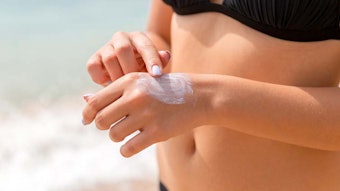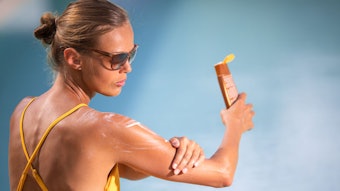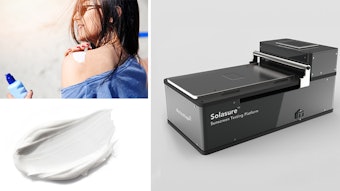
Our world typically appears in an abundance of colors from which we derive a vast amount of information. Despite this, our eyes are still only sensitive to a relatively narrow range of wavelengths—from approximately 390-720 nm. As such, while standard visible light imaging of the skin provides a good amount of information about skin condition, such as redness, erythema, overall appearance and skin tone, our eyes are not sensitive to the broader spectral ranges as low as 300 nm and as high as 3,000 nm.
Log in to view the full article
Our world typically appears in an abundance of colors from which we derive a vast amount of information. Despite this, our eyes are still only sensitive to a relatively narrow range of wavelengths—from approximately 390-720 nm. As such, while standard visible light imaging of the skin provides a good amount of information about skin condition, such as redness, erythema, overall appearance and skin tone, our eyes are not sensitive to the broader spectral ranges as low as 300 nm and as high as 3,000 nm.
At shorter wavelengths is UV light, while longer wavelengths signify infrared (IR) radiation. These both interact with skin differently than visible light and can provide information that is not perceivable by normal visible light imaging. Imaging in these regions does come with complexities, though; such as the need for specialized camera equipment, lenses, lighting and subject handling.
Given this added complexity, the reader may wonder whether these techniques are worth the effort and of what value they can be to skin care research. As the present article reveals, UV reflectance and fluorescence imaging can indeed benefit skin research. It also provides suggestions and advice to successfully apply these types of photography.
Getting the Picture
As a foundation for the present discussion, it is first useful to visualize how skin appears in UV reflectance photography; pictures of the skin under UV and normal visible light are shown in Figure 1 to highlight the differences. Visible light imaging of a subject in sunlight using a standard camera (see Figure 1a) produces a typical photograph showing skin tone and color. White and dark hairs can be seen in the beard and scalp areas, and it is possible to make out faint, darker pigmented areas such as moles on the skin.
Images of skin taken via UV light have a much different appearance. In the reflected UV light image, skin looks darker than under visible light (see Figure 1b). This is because the absorption of light by melanin rises as the wavelength shortens, resulting in stronger absorption of the UV wavelengths compared with visible light. UV light also accentuates the surface texture of skin, making lines and wrinkles seem more prominent. In these figures, the subject’s glasses also now appear black, as they have a UV protective coating on them that absorbs UV light and prevents it from reaching the eyes. Furthermore, the UV image is presented in monochrome and was taken on a standard single lens reflex (SLR) camera converted to multispectral imaging. As will be discussed later, the choice of lens and filter, as well as camera and light source, are all vital to consider when imaging in UV. Finally, the transmission spectra of the filters used for the images are shown in Figure 1c.
It is crucial to develop products that have both the ability to block or absorb UV and are easily applied, forming an even, effective layer on skin.
The interaction of light with skin is a complex process in which a number of things can happen. Light can be reflected from either the surface of the stratum corneum (SC) or from the interface between different layers within the skin. It also can be absorbed or induce fluorescence, where the incoming light interacts with specific chemical entities within the skin and is then reemitted at a longer wavelength. Examples of UV-induced fluorescence in skin are given in Figure 2. Here, fluorescence imaging emphasizes the presence of drier skin, which appears as lighter colors. Fluorescence also generates a variety of colors in bacteria-rich areas, such as within pores on the nose and forehead. These images were taken in a darkened room with a standard SLR camera and lens but with a flashlight modified to produce UVA light and block visible light.
Following, the benefits of UV reflectance and fluorescence imaging, along with application tips, are covered in more detail.
UV Reflectance Imaging of Sunscreens
UV-related skin damage is a widespread issue with more than 130,000 new cases of skin cancer being diagnosed each year in the U.K. alone—and whereby UV radiation is attributed as the main preventable cause.1 As such, formulating efficacious and protective sunscreen products is vital for both the consumer and pharmaceutical markets. To ensure products are successful, UV reflectance imaging or photography can be applied.
This technique basically involves shining UV light on skin and capturing the portion reflected in an image taken by a camera. This approach is widely used in a variety of research fields including forensics and dermatology. It is different from UV-induced fluorescence, where the incoming UV light causes skin to emit visible or IR light, which is subsequently photographed; this will be discussed later.
For UV reflectance imaging, UVA is used since UVB is more damaging to skin. Furthermore, standard commercial cameras have virtually no sensitivity below 300 nm. UVB imaging therefore has less direct applicability to skin research than even standard photographic equipment.
Product insights: Capturing accurate UV reflectance photographs of the distribution of sunscreens during spreading can provide insight into their potential for sun protection, including how they cover areas that are often missed during application, such as around the eyes.2 With the sun protection factor (SPF) scale being logarithmic, as higher and higher numbers are attained, the amount of UV being absorbed before it reaches the skin gets closer and closer to 100%. This makes it more difficult to test for improvements in the SPF protection offered by higher grades of sunscreens. In relation, the spreading of sunscreen ingredients has a dramatic impact on the overall protection offered by the film, since thinner areas of the applied film will more readily allow increased levels of UV to penetrate and damage the skin.3, 4
Challenges: One key issue when using UV reflectance photography is the shine that occurs when intense directional light is reflected from the films of topically applied creams, which results in a bright specular reflection. This can be seen on the subject’s face in Figure 3, where the sunscreen appears dark but with bright white highlight areas on the sunscreen film.
In order to minimize shine in visible light photographs, cross polarization can be used, whereby the light source and camera lenses have polarizers mounted on them at 90 degrees to each other, thereby eliminating specular shine and revealing structures deeper inside the skin. While this process is well-established for visible light photography, it has only recently been reported for the UV imaging of sunscreens, topical formulations or other applications of UV digital reflectance imaging.5 By using cross-polarized UV reflectance photography, the difference between a well- and poorly spreading product can be seen (see Figure 4).
Optimizing formulas: The poorly spreading product (see Figure 4a) shows visible streaks from the spreading process. The light areas are where the film is thinner and, as such, absorbs less of the incoming UV light. The well-spreading product (see Figure 4b) shows a much more homogeneous finish, with no obvious streaks from the application process. This would result in a more consistent sun protection behavior.
The spreading of a sunscreen product is important since, as noted, there is a strong correlation between effective in vivo SPF and the thickness of the applied sunscreen film. It is therefore crucial to develop products that both have the ability to block or absorb UV and are easily applied to skin, promoting their use by consumers while also forming an even, effective layer on skin.
Equipment: The choice of imaging equipment is crucial to capturing UV reflectance photographs. As noted, camera sensitivity—especially to UVB but also to UV in general—is low even when the device is modified for UV imaging.6 To improve this parameter, the simplest approach is to remove the internal UV/IR blocking filters from the camera and replace them with either a quartz window or a filter that only allows UV light to filter through.
An even simpler approach is to place suitable filters in front of the lens, which enables the camera to be easily used for imaging at different wavelengths. This may seem like an ideal route for the researcher; however, he or she should bear in mind that UV-transmitting filters block visible light and therefore make it nearly impossible to see the subject through the viewfinder of the camera, although “Live View” can still sometimes be used. This limitation can be a complicating factor when imaging in a clinical setting, so placing the UV conversion filter directly in front of the sensor to produce a dedicated UV camera, where the subject can still be seen through the viewfinder, is an alternative.
Lens choice: Lens choice also is important, since most modern camera lenses contain UV-blocking materials and as such are not ideal for UVA imaging. If standard camera and enlarger lenses are used, it is important to note that any light transmitted will shift toward the long wavelength end of the UVA spectrum. As such, any normal camera lens intended to be used for UV reflectance imaging should ideally be tested against a more specialized UV lens for suitability.
The Asahi Ultra Achromatic Takumar 85 mm f4.5 lens is specialized and contains quartz and calcium fluoride elements rather than glass. As such, it is ideal for imaging in UV, visible and IR lights. It is, however, rare and not readily available. Other lenses ideally suitable for UV reflectance photography include the UV-Nikkor Macro 105 mm f4.5, currently manufactured as the Rayfact PF10545MF-UV; the Hasselblad 105 mm f4.3 UV-Sonnar; and the Jenoptik 105 mm and 60 mm macro lenses.
Filter choice: As with lens choice, it is vital to choose the correct filter to enable UV to pass through while preventing the transmission of visible and IR light. A wide range of filters exists that claim to be suitable for UV photography, but not all are ideal for use with modern digital cameras. The issue comes about due to the sensitivity of camera sensors compared with film.
Earlier types of UV-passing filters, such as B+W 403, Kodak #18A, Schott UG1, Schott UG11, and Hoya U-330 to U-360, do allow UVA and even, in some cases, UVB to pass through and block the majority of visible light. However, they also allow varying degrees of IR light to pass through.
For film cameras, this was not a problem—orthochromatic film was sensitive to UV light, but not IR and, as a result, it did not matter whether the filter allowed IR to pass through. Modern camera sensors, however, are highly sensitive to IR; much more so than they are to UV. Therefore, filters that allow even small amounts of IR to pass through are to be avoided, or IR-blocking filters should be used in combination with them. Many researchers who utilize UV reflectance imaging use the current version of the Baader Planetarium Ultraviolet Venus filter, commonly known as the “Baader U,” which is extremely effective at blocking IR. Other filter options for UVA reflectance imaging include the LaLa U, offered by UVIROptics, USA; and the conversions offered by Advanced Camera Services Ltd., UK, as these are also highly effective at blocking IR.
Light source: The choice of light source also is important. Sunlight is comprised of a wide range of wavelengths from UV through IR; however, its intensity and distribution of wavelengths varies as a function of time of day, time of year, geographical location and cloud cover, so it is far from the ideal light source for research. Camera flashes normally have coatings or filters on them to minimize the amount of UV they emit. Ideally, the skin researcher should check the flash suitability using a spectrometer before assuming that quartz tubes offer more UV than uncoated glass tubes.
Dry corneocytes fluoresce and emit visible light. This enables the imaging of dry skin, psoriasis, sunscreen remanence, etc.
Another parameter that must be considered when imaging in vivo is the exposure of the subject to UV light. Therefore, both the wavelength distribution and intensity of the light sources must be assessed before they are used to illuminate skin.7 Putting all these factors together, i.e., camera choice and modification, lens, filter and light source, can enable the skin researcher to capture cross-polarized UV images of the skin and sunscreen films in vivo, such as those shown in Figure 5.8
As can be seen, the sunscreen film on the subject’s skin appears dark since it is strongly UV-absorbent, even in the UVA range. The nonpolarized image shows shine bands on the sunscreen, which are typically seen when photographing topical creams using a flash for light. Cross-polarizing the light source and camera effectively eliminates this shine and enables the amount of UVA being absorbed by the film to be imaged. By eliminating the shine bands from the product, which normally hide the amount of UV being absorbed, cross-polarized UVA imaging is directly applicable for direct measurements of sunscreen wash-off in real-life, in vivo and in-use situations.
Calibration: Finally, with visible light imaging, calibrating the amount of UVA being reflected from the skin surface can be extremely useful; for example, when trying to understand the amount of UV being absorbed by a sunscreen film. Standard camera calibration charts are unsuitable for UV reflectance photography, however, as their optical properties vary substantially across the UVA range. Spectralon diffuse reflectance standards, or simpler standards made using a mixture of carbon black, plaster of Paris and magnesium oxide, can instead be used to establish the amount of UVA reflected from the skin during imaging.9
Fluorescence Imaging of Dry Skin and Microbiome
As noted above, when UV light interacts with skin, it can be absorbed, reflected without changing wavelength, or absorbed and reemitted at a longer wavelength through the process of fluorescence. Imaging this light is simpler for the researcher from the standpoint of the camera equipment required; since visible light is typically reemitted, standard lenses and cameras can be used.
The key to successfully implementing fluorescence imaging is effectively blocking all other potential light sources from the skin and camera during the photographic process. In the case of skin imaging, the area to be photographed must be kept in the darkness, which is relatively straightforward for smaller body sites but if larger areas are to be photographed, this can become complex.
Dry skin imaging: When UVA light shines on skin, it can interact in a number of ways. Dry corneocytes fluoresce, resulting in the emission of visible light. This principle of UV-induced visible light fluorescence (UVVLF) is behind Courage and Khazaka’s Visioscan VC98 camera, commonly used for imaging dry skin, psoriasis, sunscreen remanence on skin and mosaic melanoderm patterns. Specifically, the camera uses a UVA light to create gray scale images, 6 mm × 8 mm in size, both in vitro and in vivo. Image analysis can then be conducted to determine the amount of dry skin present. Example in vivo images from normal, dry and severely dry skin are shown in Figure 6.
These images clearly show a dermatoglyphic pattern, which also provides information as to the distribution and location of skin dryness. In normal skin, shown in Figure 6a, the edges of the dermatoglyphic lines do not show the typical whitening indicative of dry skin. As the skin becomes drier, see Figure 6b, this dryness initially appears along the edges of the dermatoglyphic lines. In extreme dryness, see Figure 6c, fluorescence now occurs at the edges of the dermatoglyphic lines and across the plateau regions between the lines, indicating more widespread dryness. This can provide insight as to how skin dryness evolves and progresses.
The dermatoglyphic lines move like an accordion as the skin is flexed, so regions around the edges are subject to bending and flexing. In normal skin, which does not show signs of excessive dryness, the SC maintains its flexibility and is able to move as we do. However, as the SC begins to dry out, it loses its flexibility and becomes stiffer, and begins to delaminate and crack. Once that process begins, the corneocyte layers become detached from the skin and are exposed to the air on both the top and bottom sides, further accelerating their drying rate.
It is vital to consider all aspects of the imaging process to ensure that reliable and reproducible images can be captured.
In cases of extreme dryness, even the SC between the dermatoglyphic lines starts to dry out and crack, as can be seen by the widening extent of the fluorescence in the images.
In this way, fluorescence imaging of the skin can provide valuable insight into the evolution of dry skin. It also emphasizes the over-simplification of classifying skin as homogeneously “normal” or “dry.” Finally, it shows how maintaining the flexibility of the SC, especially in areas subject to a high degree of flexing and bending, such as at the edges of the dermatoglyphic lines, can be crucial to preventing further drying and cracking.
Microbiome imaging: As noted, illuminating the skin with UVA produces a strong fluorescence effect in the visible spectrum—some of which comes from porphyrins from the bacteria present on skin. The color of this fluorescence can be used to derive information about the presence and location of certain bacterial species on skin, as the color is driven by the chemical characteristics and structure of the porphyrins, which are specific to certain bacteria.10, 11
Example images of UV-induced visible light fluorescence of the skin are shown in Figure 2. As can be seen especially in Figure 2c, there are bright points of light on the skin’s surface that exhibit a variety of colors. These points are associated with pores, especially on the nose and forehead, and their color is determined by the fluorescence of the porphyrins present.
For example, the lipophile Propionobacterium acnes (P. acnes) fluoresces strongly in the orange-green part of the visible spectrum; specifically in the 570-630 nm region. This is due to the porphyrin Coproporphyrin III (CpIII). On the other hand, Protoporphyrin IX (PpIX) mainly fluoresces in the red part of the spectrum > 630 nm.11 By imaging the fluorescence of skin and examining the different color channels, the skin sites with higher levels of P. acnes bacteria, for example, can be determined (see Figure 7).11 Indeed, by splitting the visible light signal into the red and green channels, measurements of CpIII and PpIX fluorescence have been identified in full-facial images of acne subjects and associated with lesion-specific inflammation, i.e., acne spots, with papulopustular lesions.11
The ability to derive information on the nature of the bacteria present on skin, based on the color at which their porphyrins fluoresce, opens up the possibility of mapping bacterial distribution on the skin; for instance during the progression of atopic eczema; or during the process of washing and cleansing, where the normal bacterial population of the skin can become disturbed. Commercially available imaging systems that use this phenomenon to image porphyrins on skin include the Visia from Canfield Scientific Inc., and Visiopor PP 34 N from Courage and Khazaka.
Conclusions
UV reflectance and fluorescence imaging of the skin, while at times add complexities to the logistics of image capture, can provide novel insights into skin’s form and function that are nearly impossible to observe with standard visible light photography. Using the correct combination of camera system, lens, lighting and filters, a wide range of skin conditions can be imaged by the researcher. However, it is vital to consider all aspects of the imaging process, especially when dealing with non-visible light imaging, to ensure that reliable and reproducible images can be captured.
References
- Cancer Research UK. Melanoma skin cancer statistics. Retrieved from http://www.cancerresearchuk.org/health-professional/cancer-statistics/statistics-by-cancer-type/skin-cancer#heading-Zero
- Pratt, H., et al. (2017). UV imaging reveals facial areas that are prone to skin cancer are disproportionately missed during sunscreen application. PLoS One, 12(10), e0185297.
- Azurdia, R. M., Pagliaro, J. A., Diffey, B. L., and Rhodes, L. E. (1999). Sunscreen application by photosensitive patients is inadequate for protection. Br J Dermatol, 140, 255–258.
- Stokes, R., and Diffey, B. (1997). How well are sunscreen users protected? Photodermatol Photoimmunol Photomed, 13, 186-188.
- Crowther, J. M. (Apr 2018). Understanding sunscreen SPF performance using cross-polarized UVA reflectance photography. Int J Cosmet Sci, 40(2), 127-133.
- Crowther, J. M. (2019). Understanding color reproduction in multispectral imaging: Measuring camera sensor response in the ultraviolet, visible and infrared. Imaging Science J, 67(5), 268-276.
- British Police Scientific Data Branch (PSDB) (Jul 2001). Revised guidelines for the use of flash guns emitting ultraviolet light for the photography of evidence. Crime Scene Investigation Sector, Sandridge, St Albans, AL4 9HQ.
- Crowther, J. M. (2018). Cross polarized UVA photography for the imaging of sunscreens. ISBS Conference San Diego.
- Crowther, J.M. (2018). Calibrating UVA reflectance photographs—Standardization using a low cost method. J Vis Commun Med, 41(3), 109-117.
- Borelli, C., et al. (2006). In vivo porphyrin production by P. acnes in untreated acne patients and its modulation by acne treatment. Acta Derm Venereol, 86(4), 316-319.
- Patwardhan, S. V., Richter, C., Vogt, A., Blume-Peytavi, U., Canfield, D., and Kottner, J. (2017). Measuring acne using Coproporphyrin III, Protoporphyrin IX and lesion-specific inflammation: An exploratory study. Arch Dermatol Res, 309(3), 159-167.










